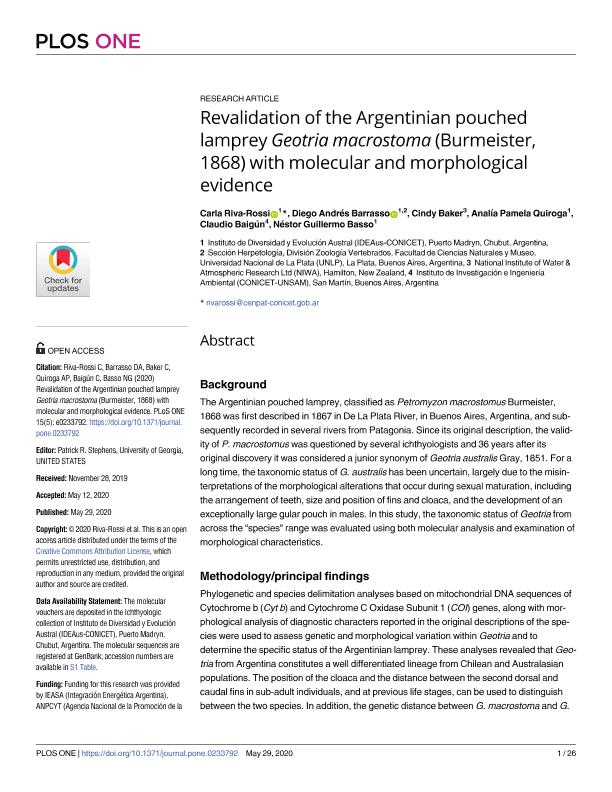Mostrar el registro sencillo del ítem
dc.contributor.author
Riva Rossi, Carla Marcela

dc.contributor.author
Barrasso, Diego Andrés

dc.contributor.author
Baker, Cindy
dc.contributor.author
Quiroga, Analía Pamela

dc.contributor.author
Baigún, Claudio Rafael M.

dc.contributor.author
Basso, Nestor Guillermo

dc.date.available
2021-01-29T12:44:16Z
dc.date.issued
2020-05
dc.identifier.citation
Riva Rossi, Carla Marcela; Barrasso, Diego Andrés; Baker, Cindy; Quiroga, Analía Pamela; Baigún, Claudio Rafael M.; et al.; Revalidation of the Argentinian pouched lamprey Geotria macrostoma (Burmeister, 1868) with molecular and morphological evidence; Public Library of Science; Plos One; 15; 5; 5-2020; 1-26
dc.identifier.issn
1932-6203
dc.identifier.uri
http://hdl.handle.net/11336/124170
dc.description.abstract
Background The Argentinian pouched lamprey, classified as Petromyzon macrostomus Burmeister, 1868 was first described in 1867 in De La Plata River, in Buenos Aires, Argentina, and subsequently recorded in several rivers from Patagonia. Since its original description, the validity of P. macrostomus was questioned by several ichthyologists and 36 years after its original discovery it was considered a junior synonym of Geotria australis Gray, 1851. For a long time, the taxonomic status of G. australis has been uncertain, largely due to the misinterpretations of the morphological alterations that occur during sexual maturation, including the arrangement of teeth, size and position of fins and cloaca, and the development of an exceptionally large gular pouch in males. In this study, the taxonomic status of Geotria from across the "species" range was evaluated using both molecular analysis and examination of morphological characteristics. Methodology/principal findings Phylogenetic and species delimitation analyses based on mitochondrial DNA sequences of Cytochrome b (Cyt b) and Cytochrome C Oxidase Subunit 1 (COI) genes, along with morphological analysis of diagnostic characters reported in the original descriptions of the species were used to assess genetic and morphological variation within Geotria and to determine the specific status of the Argentinian lamprey. These analyses revealed that Geotria from Argentina constitutes a well differentiated lineage from Chilean and Australasian populations. The position of the cloaca and the distance between the second dorsal and caudal fins in sub-adult individuals, and at previous life stages, can be used to distinguish between the two species. In addition, the genetic distance between G. macrostoma and G. australis for the COI and Cyt b mitochondrial genes is higher than both intra-and inter-specific distances reported for other Petromyzontiformes. Conclusions/significance Our results indicate that the Argentinian pouched lamprey, found along a broad latitudinal gradient on the south-west Atlantic coast of South America, should be named as Geotria macrostoma (Burmeister, 1868) and not as G. australis Gray 1851, returning to its earliest valid designation in Argentina. Geotria macrostoma can now be considered as the single lamprey species inhabiting Argentinian Patagonia, with distinct local adaptations and evolutionary potential. It is essential that this distinctiveness is recognized in order to guide future conservation and management actions against imminent threats posed by human actions in the major basins of Patagonia.
dc.format
application/pdf
dc.language.iso
eng
dc.publisher
Public Library of Science

dc.rights
info:eu-repo/semantics/openAccess
dc.rights.uri
https://creativecommons.org/licenses/by-nc-sa/2.5/ar/
dc.subject
POUCHED LAMPREY
dc.subject
PATAGONIA
dc.subject
SANTA CRUZ RIVER
dc.subject
EDEMISM
dc.subject.classification
Zoología, Ornitología, Entomología, Etología

dc.subject.classification
Ciencias Biológicas

dc.subject.classification
CIENCIAS NATURALES Y EXACTAS

dc.title
Revalidation of the Argentinian pouched lamprey Geotria macrostoma (Burmeister, 1868) with molecular and morphological evidence
dc.type
info:eu-repo/semantics/article
dc.type
info:ar-repo/semantics/artículo
dc.type
info:eu-repo/semantics/publishedVersion
dc.date.updated
2020-12-04T14:47:56Z
dc.journal.volume
15
dc.journal.number
5
dc.journal.pagination
1-26
dc.journal.pais
Estados Unidos

dc.journal.ciudad
San Francisco
dc.description.fil
Fil: Riva Rossi, Carla Marcela. Consejo Nacional de Investigaciones Científicas y Técnicas. Centro Científico Tecnológico Conicet - Centro Nacional Patagónico. Instituto de Diversidad y Evolución Austral; Argentina
dc.description.fil
Fil: Barrasso, Diego Andrés. Consejo Nacional de Investigaciones Científicas y Técnicas. Centro Científico Tecnológico Conicet - Centro Nacional Patagónico. Instituto de Diversidad y Evolución Austral; Argentina. Universidad Nacional de La Plata. Facultad de Ciencias Naturales y Museo. Departamento Científico Zoología Vertebrados; Argentina
dc.description.fil
Fil: Baker, Cindy. National Institute Of Water And Atmospheric Research; Nueva Zelanda
dc.description.fil
Fil: Quiroga, Analía Pamela. Consejo Nacional de Investigaciones Científicas y Técnicas. Centro Científico Tecnológico Conicet - Centro Nacional Patagónico. Instituto de Diversidad y Evolución Austral; Argentina
dc.description.fil
Fil: Baigún, Claudio Rafael M.. Universidad Nacional de San Martín. Instituto de Investigación e Ingeniería Ambiental. - Consejo Nacional de Investigaciones Científicas y Técnicas. Oficina de Coordinación Administrativa Parque Centenario. Instituto de Investigación e Ingeniería Ambiental; Argentina
dc.description.fil
Fil: Basso, Nestor Guillermo. Consejo Nacional de Investigaciones Científicas y Técnicas. Centro Científico Tecnológico Conicet - Centro Nacional Patagónico. Instituto de Diversidad y Evolución Austral; Argentina
dc.journal.title
Plos One

dc.relation.alternativeid
info:eu-repo/semantics/altIdentifier/url/https://dx.plos.org/10.1371/journal.pone.0233792
dc.relation.alternativeid
info:eu-repo/semantics/altIdentifier/doi/https://doi.org/10.1371/journal.pone.0233792
Archivos asociados
